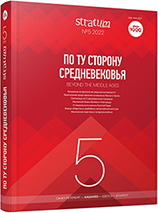Изображения персонажей с перекрестно сложенными руками в искусстве Семиречья и Южного Казахстана VI—X вв. (по материалам археологии)
Images of Characters with Folded Arms in art of Semirechye and South Kazakhstan 6th—10th centuries (based on archeology materials)
Author(s): Galina A. TernovayaSubject(s): History, Archaeology, Ethnohistory, 6th to 12th Centuries
Published by: Издательский дом Stratum, Университет «Высшая антропологическая школа»
Keywords: Semirechye; South Kazakhstan; Turks; Sogdians; cult objects; traditions; Zoroastrianism; fravashi; Christianity;
Summary/Abstract: A collection of objects with images of characters, whose arms are folded crosswise on their chest, has been collected over many years of research into the medieval urban culture of Semirechye and South Kazakhstan. These objects are made of terracotta, clay, bronze. Considering the total number of finds dated to the 6th—10th centuries, the popularity of these images can be noted. Their appearance is associated with the influence exerted by the Sogdians. The images correlate with the cult of ancestors, ideas about the afterlife, the posthumous existence and the subsequent resurrection of the dead. An early find is a fragment of a terracotta Christian icon of the 5th—6th centuries with a Syrian inscription, which probably got to the city of Taraz along the Great Silk Road. The article presents the version that the scene “Resurrection” is reproduced on the icon. The ossuaries, decorative clay columns, bronze amulets supposedly depict Avestan fravashi. The origins of the gesture can be traced in the art of Ancient Egypt, Etruscans, Iran, Byzantium, Sogd. The prayer gesture with folded hands has been preserved in ritual practice and religious art to this day.
Journal: Stratum plus. Археология и культурная антропология
- Issue Year: 2022
- Issue No: 5
- Page Range: 217-232
- Page Count: 16
- Language: Russian
- Content File-PDF

